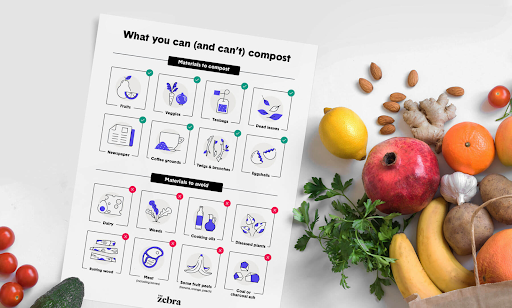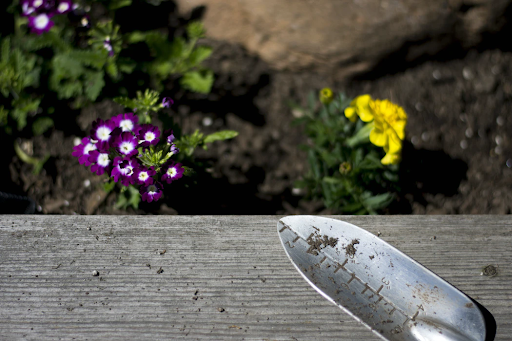How to Compost at Home (6 Easy Steps!)
*Royalty-free image source here
Now is the perfect time to pick up a hobby you can do from home. Composting is an eco-friendly activity that lets you reduce your family’s waste while also creating healthy soil feeder. Pair your compost with organic fertilizer and sprinkle on your yard and garden for a fruitful harvest!
Read on to discover more about composting, what you can and can’t compost, and how to create a compost pile at home.
How composting works
Compost is nutrient rich topsoil created by speeding up the natural decomposition process of organic materials. Rather than tossing nutrient rich waste such as eggshells and coffee grounds, you can add them to your compost pile and transform them into food for your soil.
Nearly 25% of all solid waste from U.S. households comes from the kitchen. Composting is a great way to reduce your carbon footprint by preventing nutrient rich waste from ending up in the trash can.
Materials you can (and can’t!) compost
Not all of your kitchen waste is good for your compost pile. In fact, compost is very picky about what it breaks down!
The key is to find scraps rich in either carbon or nitrogen. If you add the wrong materials into your pile, it may begin to produce a rotten egg smell, delay composition, or even poison your pile. Hang this free kitchen printable near your bin so you know what to keep for compost and what to toss instead.

So what nutrient rich waste should you add to your compost? It should be a mix of browns and greens. Browns are materials rich in carbon, whereas greens are materials rich in nitrogen. Both are essential for the decomposition process, but you should have a ratio of 3:1 browns to greens.
Brown compost materials:
You can find carbon-rich ingredients in your kitchen and in your yard. Here are some of the most popular brown compost materials:
- Branches and twigs
- Shredded newspaper
- Dead leaves
- Egg shells
Green compost materials:
You’ll find most of your nitrogen-rich ingredients in your kitchen. These green compost materials include:
- Fruits
- Veggies
- Old flowers
- Loose tea/tea bags
- Coffee grounds/filters
Materials to skip:
Remember that not every ingredient in your kitchen should end up in your compost pile. In fact, most shouldn’t. Here are the materials to avoid when composting:
- Dairy
- Citrus fruit peels
- Meat
- Cooking oils
- Diseased plants/weeds
- Coal or charcoal ash
How to set up an outdoor compost pile
If you are looking to set up a compost pile in your backyard or at a nearby community garden, follow these simple steps!
1. Choose a shady spot
Compost prefers to do its work in the shade. Look for a spot in the yard that doesn’t get much direct sunlight. Bonus points if it is near a water source! Then decide whether to build a compost pile using pallets, digging a hole into the ground, or purchasing a compost bin.
2. Gather compost materials
Now it’s time to gather your compost materials! We recommend setting up an extra bin in your kitchen to gather your materials and then sort through them. Remember that you’ll want more browns than greens!
3. Begin layering your compost
Now it’s time to begin layering your compost. Start with a brown layer first, and then add a smaller green layer on top. You can sprinkle soil from your yard in between each layer to add some additional healthy nutrients.
4. Add moisture to your pile
Water is another essential ingredient for the decomposition process. Use your water source to add moisture once a week. If it rains, you may not need to add additional moisture. Remember that you want your pile moist but not soggy.
5. Aerate your compost:
Next you’ll need to aerate your compost. We recommend doing this once or twice a week. The most popular method for aeration is with a shovel. After you aerate a few times, you should begin to see your organic materials slowly start to break down. This is a sign that decomposition is working! Even better when you notice your compost beginning to feel warm and steamy.
6. Use your compost as soil feeder
Once all the organic materials have broken down and your compost resembles crumbly topsoil, it should be ready to use! This process usually takes two to four months. Your compost should smell pleasant and earthy, with no foul odors. Now it’s time to sprinkle your compost onto your yard! Don’t forget to add in organic fertilizer to your topsoil.
One of the great things about composting is that you can customize your project to fit your spaces needs. While composting outdoors is the preferred method, there are also additional indoor methods such as vermicomposting and fermentation available for those who don’t have space in their yard.
Read on to learn about alternative composting methods with this visual from The Zebra below or check this guide out!
Attribution: TheZebra.com


